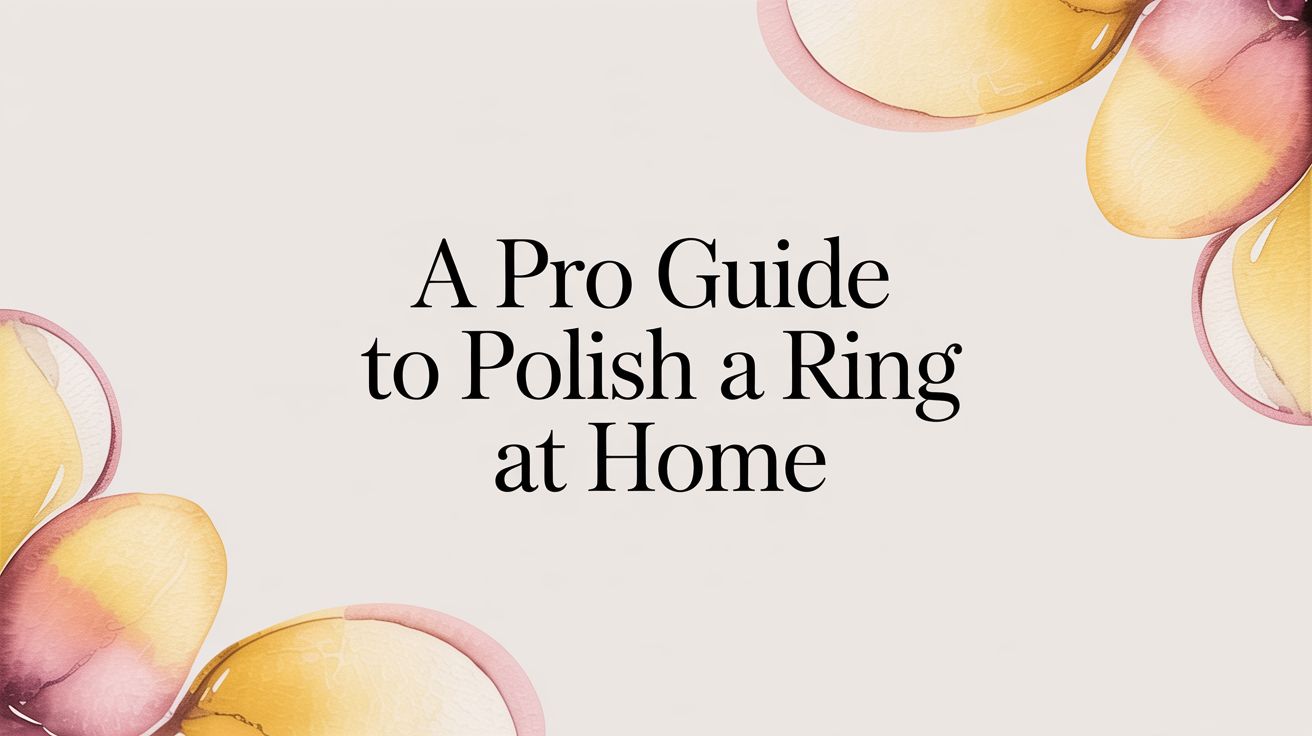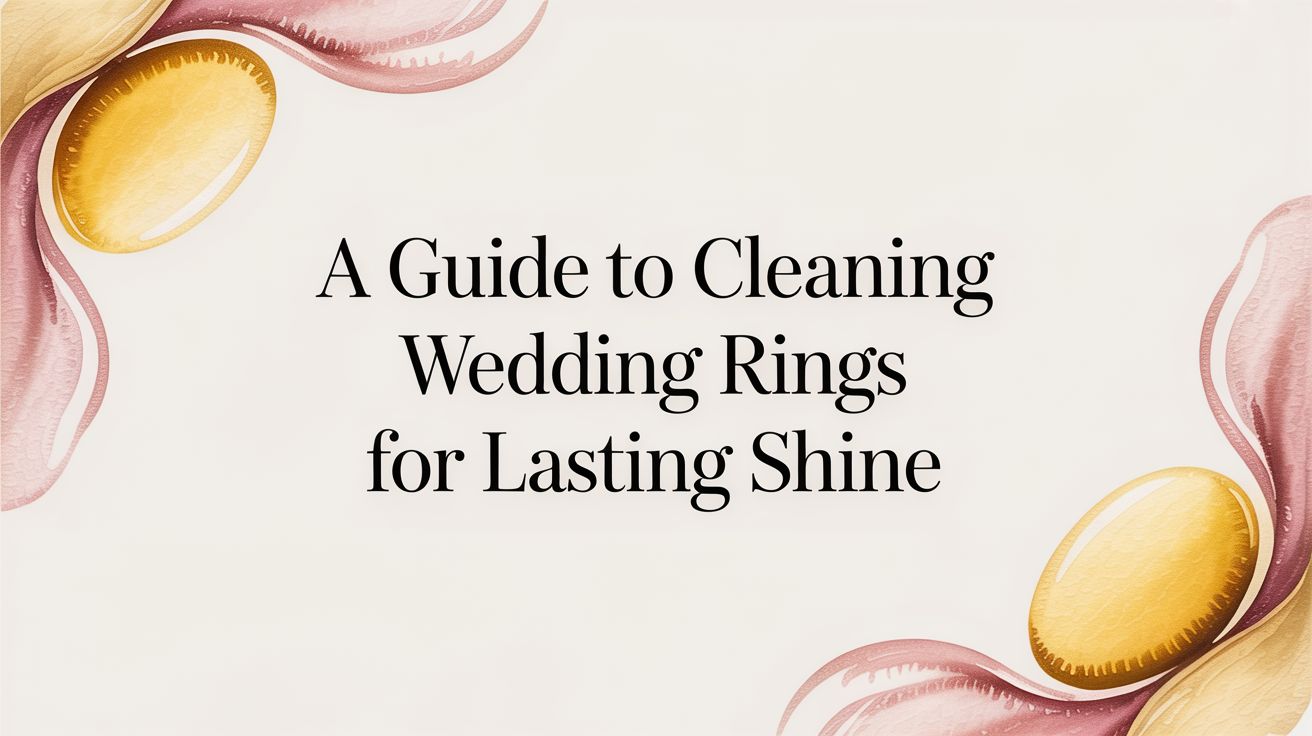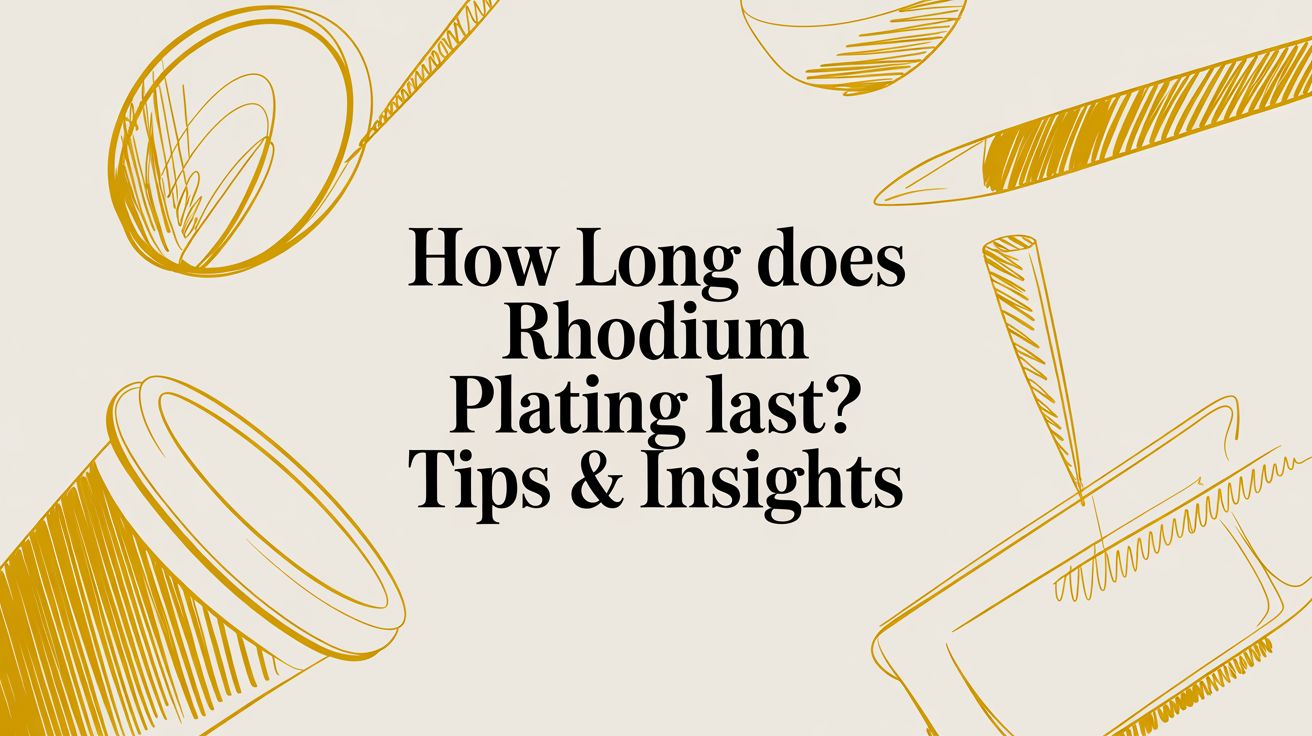That familiar sparkle on your favourite ring can fade over time, leaving it looking a little tired and worn. The good news? Restoring its original brilliance is often something you can do yourself. This guide will walk you through the proper techniques to polish gold, silver, and platinum right at home, helping you bring those cherished pieces back to life safely and effectively.
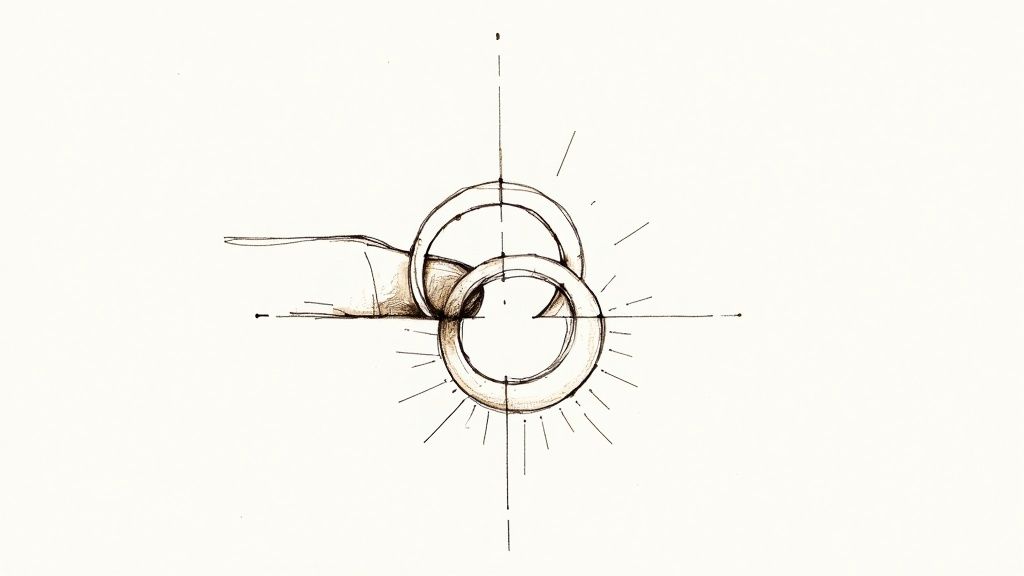
Why You Should Polish a Ring
Bringing back a ring's shine is about more than just looks; it’s a crucial part of maintaining its value and sentimental meaning. Daily wear inevitably exposes rings to oils, lotions, and microscopic scratches that create a dull film over the metal. A proper polish carefully removes this build-up and smooths the surface, letting light reflect brilliantly once again.
Here, we'll get into the specifics:
- How to figure out what kind of wear your ring has, from minor scuffs to a general lack of lustre.
- Which tools are genuinely needed for an effective at-home polish.
- How to set up your workspace to avoid any accidental damage.
With the UK jewellery market valued at £4.4 billion in 2023 and still growing, the demand for quality jewellery care is clear. Learning to polish a ring yourself empowers you to maintain your own collection. For more on basic care, you might find our guide on how to clean rings at home useful.
A common mistake is confusing cleaning with polishing. Cleaning removes surface grime, but polishing is what truly restores that deep, mirror-like shine by addressing the fine scratches that cause dullness.
By learning the right methods, you can confidently revive your ring's appearance without compromising its integrity. We'll explore gentle techniques for different metals and show you how to handle everything from a simple wedding band to a more intricate design, ensuring you get that professional-looking finish every time.
Getting Your At-Home Polishing Kit Together
To get a professional-looking shine on your ring at home, you need the right kit. It’s tempting to grab whatever you have under the sink, but using the wrong supplies can do more harm than good, turning a simple job into a costly repair. Luckily, you only need a few key items to do this properly, and you probably have some of them already.
The most important tool is a proper jewellery polishing cloth. I can't stress this enough – it's not the same as a standard microfibre towel from the supermarket. Good ones are often double-layered; one side is treated with a very fine, non-abrasive rouge that lifts tarnish, while the other is for buffing up that final, brilliant shine. They’re designed specifically for soft precious metals like gold and silver, so you can be confident you’re removing grime, not creating new scratches.
Essential Cleaning and Polishing Supplies
First things first, you need to give the ring a gentle clean. For this, all you'll need is:
- A small bowl to mix up your cleaning solution.
- Warm water – never hot, as a sudden temperature change can damage delicate gemstones.
- Mild, phosphate-free washing-up liquid. Just a couple of drops will do the trick.
- A very soft-bristled brush. Think baby’s toothbrush. This is perfect for getting into detailed settings and intricate designs without scratching the metal.
Before you start, set up a clean, organised workspace. I always recommend laying down a soft towel to work on. It stops your ring from rolling away and protects it from getting scuffed on a hard tabletop if you accidentally drop it.
One thing to avoid at all costs is common household chemicals. Bleach, chlorine, and even toothpaste are far too abrasive for jewellery. They can cause permanent damage, strip away plating, or etch the surface of the metal itself. Just stick to the simple, purpose-made supplies.
Choosing the right cloth is the most crucial part of achieving a flawless polish. Different metals need different care, and using the wrong texture can leave your ring looking worse than when you started.
Choosing the Right Polishing Cloth for Your Ring
Here’s a quick breakdown to help you pick the perfect cloth for your specific ring, ensuring you get the best shine without risking any damage.
| Cloth Type | Best For | Key Feature |
|---|---|---|
| Treated Polishing Cloth | Gold, Silver, Platinum | Impregnated with micro-abrasives to remove tarnish and fine scratches. |
| Untreated Microfibre | General Buffing & Drying | Excellent for removing fingerprints and water spots after cleaning. |
| Selvyt Cloth | High-Shine Finishes | A traditional, non-abrasive cotton cloth perfect for a final, brilliant buff. |
With these simple items ready to go, you’ve got everything you need to safely polish your ring and bring back its original lustre.
The Gentle Polishing and Cleaning Method
With your workspace ready and your tools laid out, it's time to bring that sparkle back to your ring. This is a gentle but effective method that works beautifully on common metals like gold and silver. It all starts with a thorough clean – you simply can't get a mirror finish by rubbing dirt and grime into the metal.
First things first, we need a simple cleaning solution. Just mix a few drops of a mild, phosphate-free washing-up liquid into a bowl of warm water. It's best to avoid hot water, as a sudden temperature change can be a shock to certain gemstones. Let your ring soak for around 15-20 minutes. This little bath is crucial for loosening the daily build-up of oils, lotions, and dust that gets trapped in all those tiny crevices.
Cleaning with Care
Once it's had a good soak, take an ultra-soft brush—a baby's toothbrush is perfect for this—and gently scrub the ring. You'll want to pay close attention to the detailed areas, like around the gemstone settings or inside any engravings, as that’s where dirt loves to hide. The idea is to dislodge any grime without scratching the metal.
When you're happy it's clean, rinse the ring under cool, running water. Then, pat it completely dry with a fresh, lint-free cloth. For a more detailed guide, have a look at our specialist advice on how to clean gold jewellery.
Now that the ring is perfectly clean and dry, we can move on to the actual polishing. This infographic breaks down the simple three-step flow of the whole process.
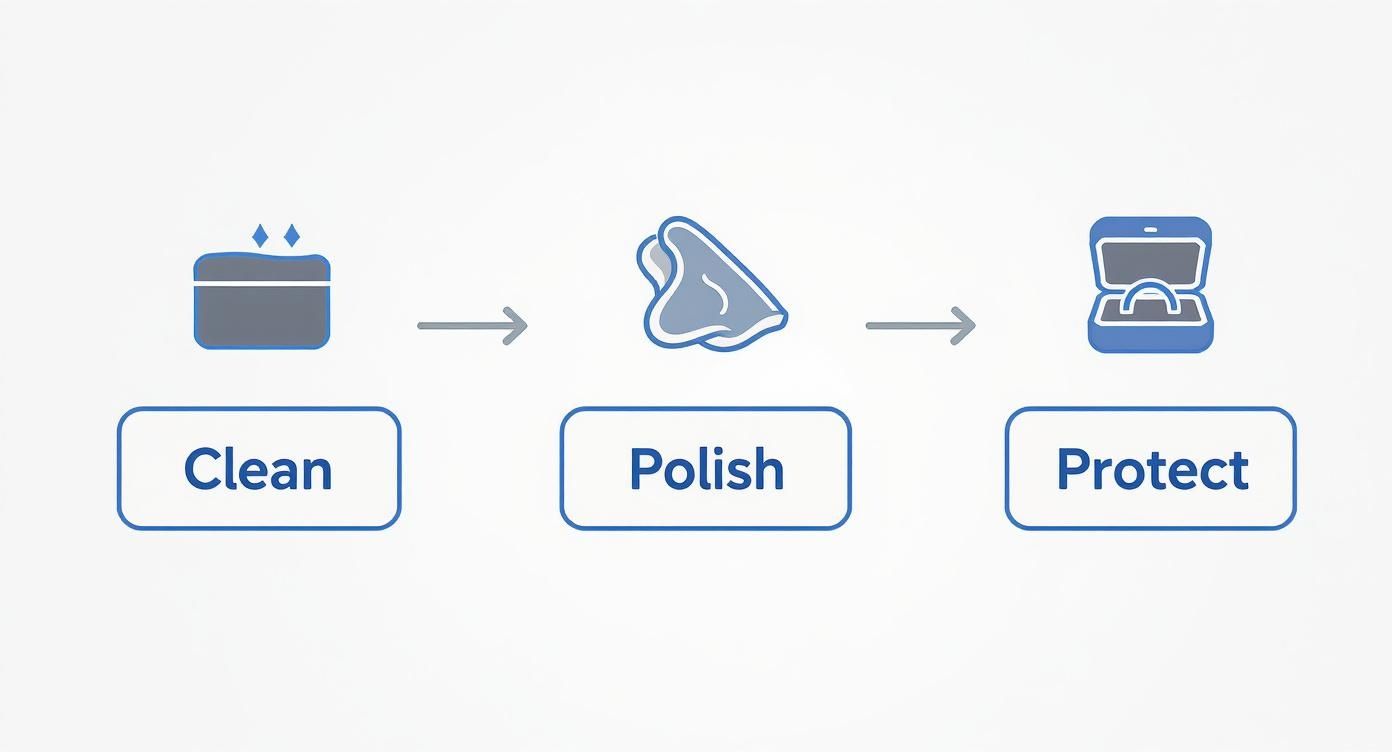
As you can see, a great polish isn't just one action. It’s a sequence where each step builds on the last to give you that brilliant, lasting shine.
The Art of the Final Polish
Take your treated polishing cloth and apply light, consistent pressure. Here's a key tip: always polish in straight, back-and-forth motions along the band. It's a common mistake to polish in circles, but this can create tiny swirl marks that actually diffuse light instead of reflecting it. Straight lines ensure you're buffing the surface evenly, which is what brings out that gorgeous lustre.
Remember, the aim is to gently buff, not to aggressively scrub. Let the specially treated cloth do the work. You'll notice the cloth picking up dark residue—this is the tarnish and microscopic layer of metal being removed to reveal the fresh, gleaming surface beneath.
This kind of careful maintenance is so important. In the UK, the jewellery market saw a revenue of USD 5,760.8 million in 2024, and rings are the largest segment, making up 36.3% of that share. Taking the time to polish a ring correctly doesn't just preserve its beauty; it protects its value too. You can discover more insights on the UK jewellery market from Grand View Research.
Keep buffing until you're happy with the shine, then use a clean part of the cloth for one final wipe to remove any lingering residue.
Handling Scratches and Specific Metal Care
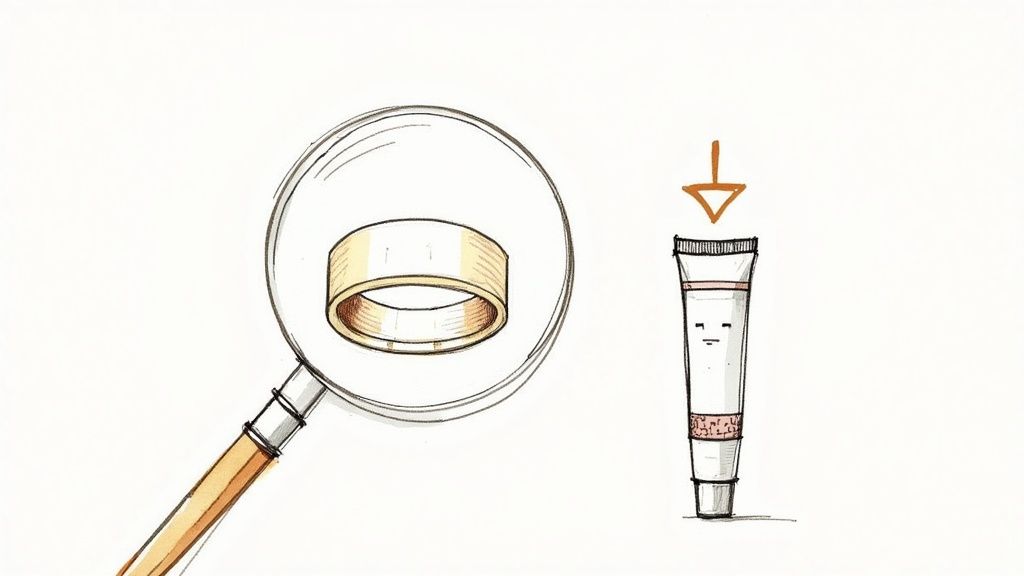
Not all rings are created equal. A one-size-fits-all approach to polishing can easily lead to disappointment, or worse, damage to a treasured piece. The type of metal, the finish, and how worn it is all dictate the right technique.
Light surface scuffs are a common sight, especially on softer metals like sterling silver and high-karat gold. The good news is these can often be sorted out at home. A dab of specialised polishing compound on your cloth can work wonders – just use it sparingly and buff the area gently in a straight line.
But it’s crucial to know your limits.
The rule of thumb is simple: if you can feel a scratch with your fingernail, it's too deep to fix yourself. Trying to buff out a deep gouge will only wear away the surrounding metal, leaving an uneven, wavy finish. That kind of damage is a job for a professional jeweller with proper buffing machinery.
Knowing when to stop is just as important as knowing how to start. It’s easy to get carried away, but over-polishing can erode delicate details and thin the band over time.
Tailoring Your Technique for Different Metals
The way you approach polishing a ring changes completely depending on what it’s made of. Every metal has its own personality, from hardy platinum to delicate gold plate.
- Sterling Silver: This metal is famous for tarnishing – that dark discolouration is just a chemical reaction with sulphur in the air. A good quality silver polishing cloth is your best friend here, perfect for lifting tarnish and tackling minor scratches.
- Gold (Yellow, Rose, White): Higher-karat golds like 18k are softer and pick up scratches more easily. You need a very gentle touch and a non-abrasive cloth. If you have a white gold ring, remember that its bright white shine often comes from a thin layer of rhodium plating, which aggressive polishing can wear away.
- Platinum: As a dense and extremely durable metal, platinum doesn't tarnish. Instead, it develops a soft, satin finish over time known as a patina, which many people actually prefer. Polishing will remove this and restore a high shine, so whether you do it or not is purely down to personal taste.
Rings with Gemstones Need Extra Care
When your ring has gemstones, the stones must be your priority. Polishing compounds are abrasive and can easily damage softer, more porous stones like opals, pearls, or turquoise. Worse, the chemicals can get lodged underneath the setting, causing skin irritation or discolouring the stone's backing.
Always work carefully around the gemstone, focusing only on the metal band. A soft cloth is usually all you need for this delicate job. If the setting is quite intricate, try using a cotton bud to apply a tiny amount of polish just to the metal, making sure none of it touches the stone.
If you’re ever in doubt, it’s always safer to step away and seek a professional’s help.
Keeping That Showroom Shine Long-Term
Once you’ve put in the effort to polish a ring, you want that gleam to last. The secret isn't more aggressive polishing; it's about smart daily care and a few preventative habits. Making some simple changes to your routine can dramatically reduce how often you need to do a full-on polish.
A huge part of this is just protecting your ring from its environment. Think about what your hands go through every day. Things like washing up, gardening, or hitting the gym expose your ring to harsh chemicals and the risk of knocks and scratches.
Storing your jewellery properly is just as important. Just tossing everything into one box is a recipe for disaster—and a lot of new scratches. Get into the habit of using individual soft pouches or a lined jewellery box with separate compartments. It stops your rings from rubbing against each other.
A Simple Maintenance Schedule
To keep on top of daily build-up, a simple routine is all you need. A quick wipe-down with a soft, lint-free cloth once a week is usually enough to lift away skin oils and dust.
This kind of careful upkeep is becoming more and more common. As people look for more sustainable ways to enjoy their valuables, maintaining existing pieces is a major trend. It’s a key factor contributing to a UK jewellery industry revenue projected to hit £8.1 billion in 2025. You can read a bit more about these UK jewellery market trends over on ibisworld.com.
Here are a few final tips for locking in that long-term shine:
- Dodge harsh chemicals: Always slip your ring off before you use cleaning products, hairspray, or perfume. These can create a dull film that’s tough to remove.
- Watch out for chlorine: Remember to take your ring off before you hop into a swimming pool or a hot tub. Chlorine can damage and discolour precious metals over time.
- Give it a gentle clean: Every few weeks, a quick wash with a bit of mild soap and warm water will work wonders to restore its sparkle.
These small habits make a massive difference. They don't just preserve the metal; they prolong that beautiful, freshly polished lustre for years to come.
Common Questions About Ring Polishing
Even with a clear guide, you'll likely have a few questions before you start. Getting these details right is what separates a decent result from a great one, giving you the confidence to get it done properly.
How Often Should I Polish My Ring?
This is easily the most common question we get. While a gentle wash with soap and water is fine every week or so for rings you wear daily, a full polish is a completely different beast.
Think of it as a more intensive treatment. You should only really be doing it every few months, or when you notice the shine has genuinely dulled.
Remember, polishing works by removing a microscopic layer of metal to smooth out scratches. Overdoing it, especially with abrasive compounds, can gradually wear down the band and delicate settings over time. Less is definitely more.
What About Rings With Gemstones?
Another frequent concern is how to handle rings with gemstones. The short answer is yes, you can polish them, but you have to be extremely careful. The absolute key is to protect the stones from any polishing agents.
For hard stones like diamonds or sapphires, you can clean around them, but be careful not to catch a cloth on the settings and loosen them. However, you should never use polishing compounds near porous gemstones. This includes:
- Opals
- Pearls
- Turquoise
- Coral
These delicate stones can actually absorb the chemicals in the compounds, which can lead to permanent discolouration. Stick to using just a soft cloth on the metal band itself and steer clear of the gems.
If your ring has a plated finish, like white gold, it’s also vital to polish gently to avoid wearing through the coating. You can find out more about how long plating lasts in our article on rhodium plating durability.
For a professional finish without any of the risk, it’s always best to trust the experts. Here at Opulence Jewellery Services, our Hatton Garden workshop offers while-you-wait polishing to restore your ring's brilliance safely and correctly. Visit us at https://www.opulencejewelleryservices.co.uk.
